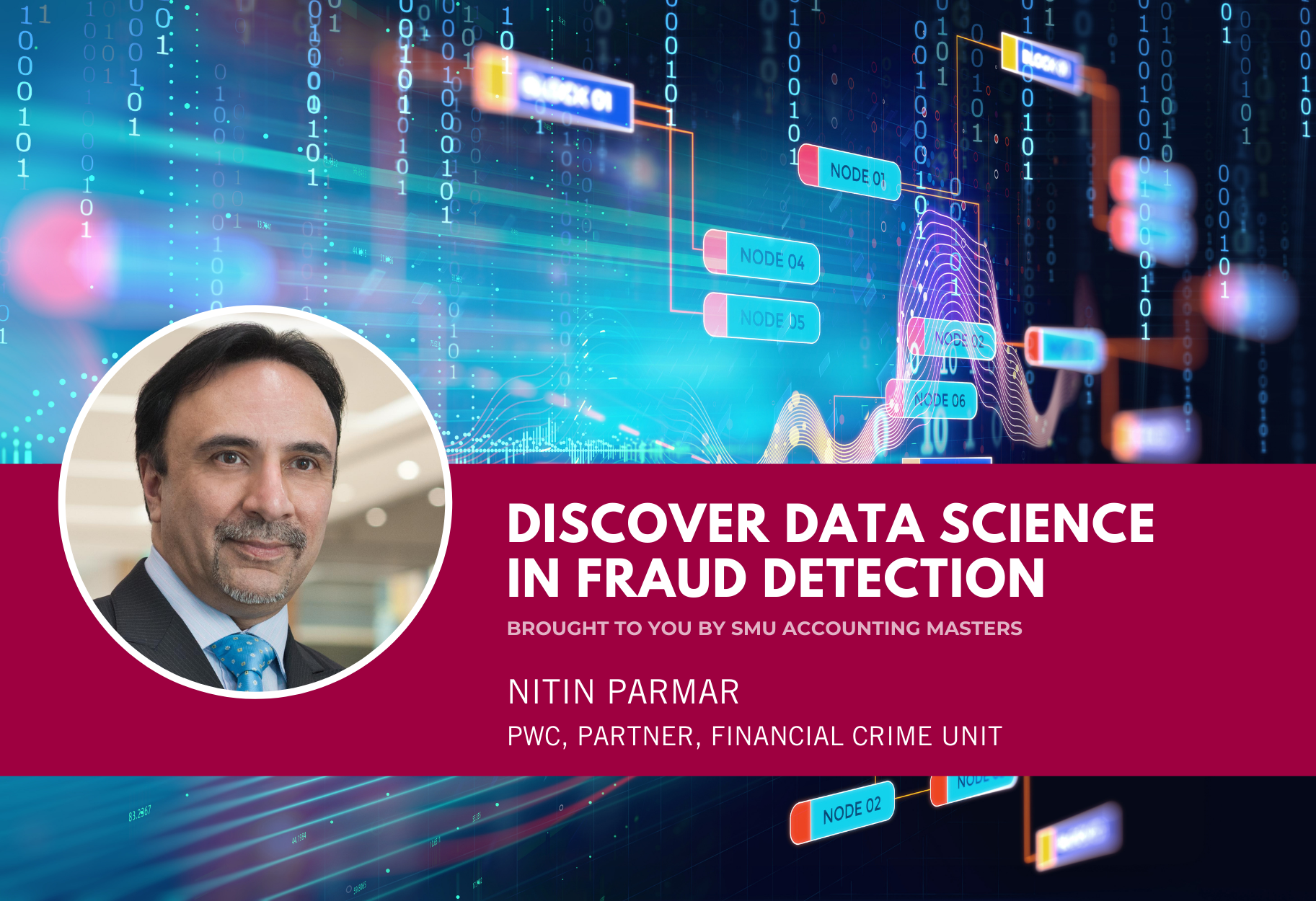Fraud rates have been going up at an alarming rate, especially during Covid-19. Banks are behind the curve in detecting accurately fraud cases and resolving them. Data science techniques used with a Forensic and Financial Crime mindset can be applied to improve fraud detection. During an industry talk organized for our SMU Accounting students, Nitin Parmar, PwC’s Partner of the Financial Crime Unit, shared with us the approach that PwC has taken, and the Data Science Techniques used for Banking and Payments Fraud Detection.
Parmar discussed in detail the most recent mindset of applying data science in forensic accounting, and especially how fraud crimes have evolved. He cited two case studies on bank fraud and showed how the crime was conducted, revealed and the steps taken by the banks to protect themselves against future fraudulent activities.
In the first case study, fraudsters hacked a well-known online ticket system stealing thousands of credit card details. The hackers strategically targeted the weaker banks and planned for the attack during a holiday weekend when most people were not paying attention to their credit card transaction details. The bank only learned of the situation one month later when customers realised they were wrongly billed. After an audit was performed, it was discovered that the bank had failed to use intelligence to update their risk assessment on merchants’ channels or use safeguards such as multi-factor verification. They also did not profile transactions people made as consumers that would have detected the unusual spike and could have then denied further transactions. The attack could have been prevented at a much earlier stage and would have reduced the bank’s losses significantly. Once the bank had rectified the problems identified in the audit, another attack was assimilated, and the bank’s system caught it with the help of technology.
In the second case study, a tier-one Australian bank had a referral programme where anyone could refer customers to the bank and get a commission. It was a successful programme, but it was the beginning of many problems. Firstly, there was no real verification of who these customers were as the bank worked directly with the referees. Secondly, there were no background checks performed on the customers to identify if they had any criminal background. The bank also did not verify the bank slips’ authenticity. Bank workers were free to approve the commissions without audit and further inflated the commissions to get paid. After an investigation was conducted, the bank deployed a fraud monitoring system that could flag any suspicious activity as well as conduct background checks on customers. They also started profiling employees so that any spike in the volume of applications and commission rates were identified.
Parmar goes on to share how the following actions can assist banks in fraud detection:
1. The Machine Learning Approach
Current rule-based systems have been overcome as criminals have been able to study them to find vulnerabilities. In comparison to Machine Learning which can spot anything that varies from the baseline behaviour using techniques such as topological data analysis which looks at the shape of the clusters and underlying points and has strong mechanisms that highlight deviations. Parmar foresees that this will be the de facto technique in a few years. Blockchain has immense potential too but is extremely expensive to implement and the cost will only come down if the carbon footprint and energy consumed in the blockchain process goes down with more efficient technologies.
2. Fraud Management Life Cycle
Proactive fraud detection in banking is essential for providing security to customers and employees. The sooner a bank detects fraud, the faster it can restrict account activity to minimize loses. By implementing a series of fraud detection schemes, banks can achieve necessary protection and avoid significant loses. It is also recommended that banks profile every device and channel such as mobile banking and ATMs to capture key risk indicators and transactions and apply profiling, anomalies, and changes in behaviour. It can then feedback for self-learning mechanisms.
3. The Importance of Profiling
Parmar explains that the customer’s behaviour needs to be profiled so that the system can build up a baseline of behaviour over the years and finds variations in that behaviour.
To conclude, as the banking industry is extremely susceptible to fraud, systems and processes need to be in place to mitigate fraud loss. Keeping in mind that machine learning and data science is a double-edged sword, and with skilled fraudsters circumventing even the most sophisticated fraud detection techniques, banks must rely on technological avenues to keep fraud at a minimum. As fraud experts have to work out the type of typology, this demonstrates the need for experts with accounting and mathematical skills.
SMU School of Accountancy offers the Master of Professional Accounting (MPA) and Master of Science in Accounting (Data & Analytics) (MSA) programmes that prepare a new generation of accounting professionals equipped with high-level data analytics and programming skills.
For more information, please email mpa@smu.edu.sg or msa@smu.edu.sg.





